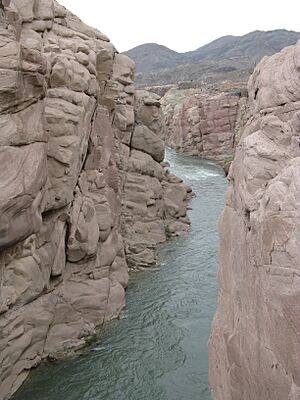Jáchal River facts for kids
The Jáchal River is an important river in Argentina. It flows through the San Juan province. This river is a key part of the larger Desaguadero River system. It is one of the most important rivers in the area. The Jáchal River starts where two smaller rivers meet. These are the Río de la Palca and the Blanco River. This meeting point is in the northwest of San Juan.
The river usually carries about 9 cubic meters of water every second. This makes it a strong and steady water source.
Contents
River's Journey
From where it begins, the Jáchal River flows south for about 75 kilometers (47 miles). It reaches a deep valley in the mountains called Cuesta del Viento. Here, the river changes direction. It turns east and flows for 40 kilometers (25 miles) through a narrow, steep canyon. This path leads towards the city of San José de Jáchal.
After passing Jáchal city, the river turns south again for another 40 kilometers (25 miles). Then, it flows in a northeast-southeast direction. It goes past the towns of Tucunuco and Mogna. Finally, after flowing for about 100 more kilometers (62 miles), the Jáchal River joins the upper Desaguadero River. This part of the Desaguadero River is also known as the Bermejo River.
How the River Gets Water
The Jáchal River mainly gets its water from melting snow. This happens in the mountains. Rain does not add much water to the river. This is because the area around the river is very dry. The river's entire water collection area covers about 34,232 square kilometers (13,217 square miles).
River Dams
The Jáchal River has two dams built on it. Dams help control the river's flow.
Cuesta del Viento Dam
The Cuesta del Viento Dam is about 40 kilometers (25 miles) from Jáchal. This dam can hold a lot of water, up to 136 million cubic meters. It helps to control the river's water. This water is then used for watering farms. There are also plans to finish building a power station here. This station will use the river's water to make electricity.
Salto de la Loma Hydroelectric Plant
Another dam is the Salto de la Loma hydroelectric plant. It is about 4 kilometers (2.5 miles) northwest of Jáchal. This plant uses a 40-meter (131-foot) high waterfall. It can produce about 1,200 kilowatts of power. This power is also used to create electricity.
Environmental Concerns
The Jáchal River is the most important natural water source for its valley. People use its water for homes, farms, and factories. However, the water quality is not always good. It naturally has a lot of minerals, like salts and boron. For example, boron levels have been found at 2.8 parts per million. For sensitive crops like grapes, levels above 0.7 parts per million are considered too high.
Mining and Water Quality
In the early 2000s, a large Canadian mining company started a gold mining project. This project was in the mountains of San Juan. Some people in San Juan were worried about this project. They thought that the gold mining process, which uses cyanide, could pollute the Jáchal River. It could also affect the San Juan River.
In 2015, the mining company stated that about 224,000 liters (59,170 gallons) of a "cyanide solution" had spilled. This spill affected the Jáchal River and four other nearby rivers. The company said the spill happened because of a broken valve. The company and local mining officials said the spill was not a danger to people. However, the government of San Juan province told people to drink only bottled water until they received more information.
See also
 In Spanish: Río Jáchal para niños
In Spanish: Río Jáchal para niños


